Embark on a spiritual journey through Laos’ most sacred temples, from the golden Pha That Luang to the ornate Wat Xieng Thong. Discover the rich history, stunning architecture, and cultural significance of these Laotian sacred sites in this ultimate Laos travel guide for 2025.
Laos, a serene gem in Southeast Asia, captivates with its tranquil landscapes and profound cultural heritage. At its heart lie the Laos temples, radiant symbols of Buddhist spirituality and architectural brilliance. From the UNESCO-listed Wat Xieng Thong in Luang Prabang to the ancient Khmer ruins of Wat Phou, these Laos Buddhist temples offer a glimpse into the nation’s soul, weaving together history, art, and devotion. Whether you’re a culture enthusiast or a spiritual traveler, visiting these Laotian sacred sites is an unforgettable experience. Here are the top 10 Laos temples you should visit in your next Vietnam Cambodia Laos tour, each a testament to the country’s vibrant Laos cultural heritage.
Pha That Luang – Vientiane’s Iconic Laos Buddhist Temple
Pha That Luang, the “Great Stupa,” stands as Laos’ most revered monument and national symbol, featured on the country’s currency and emblem. Located in Vientiane, this golden stupa towers 45 meters high, its gold-leaf exterior shimmering in the tropical sun. Originally constructed in the 3rd century to house a relic of the Buddha, the current structure was rebuilt in the 16th century under King Setthathirath, with restorations in the 1930s during French colonial rule. Its three-tiered design symbolizes stages of Buddhist enlightenment, encircled by smaller stupas, Naga snake statues, and images of King Jayavarman VII.
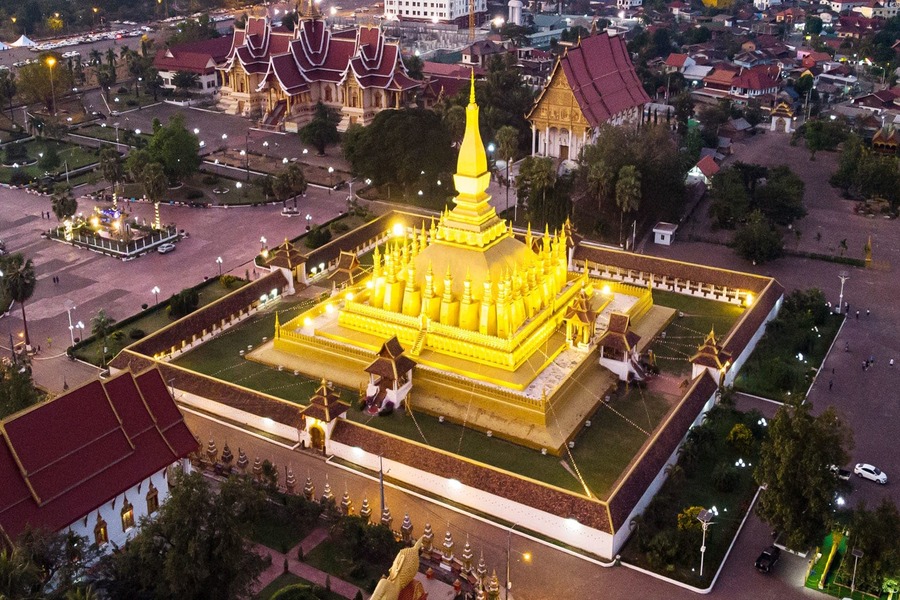
The temple’s fortress-like walls and tranquil gardens create a peaceful setting for reflection. Visiting during the That Luang Festival in November, held during the full moon of the twelfth lunar month, immerses you in vibrant processions and almsgiving ceremonies, showcasing the spiritual depth of Vientiane temples.
Travel Tip: Visit Pha That Luang from Tuesday to Sunday (8 AM–12 PM, 1 PM–5 PM) for a modest entrance fee of about 5,000 kip (~$0.23). Dress respectfully, covering shoulders and knees, to honor this sacred Laos Buddhist temple.
Wat Xieng Thong – Luang Prabang’s Jewel of Laos Temples
Wat Xieng Thong, nestled at the confluence of the Mekong and Nam Khan rivers in Luang Prabang, is one of the most exquisite Luang Prabang temples. Built in 1559–1560 by King Setthathirath, this temple exemplifies classic Lao architecture with its sweeping, multi-tiered roofs and intricate gold stenciling. Its vibrant mosaics, including the iconic “Tree of Life” mural, and a rare reclining Buddha statue make it a cultural treasure. As a former royal temple, it hosted coronations and remains a focal point for Pi Mai (Lao New Year) celebrations.
The Royal Funerary Chariot Hall, housing King Sisavang Vong’s funeral carriage adorned with golden Naga motifs, adds to its allure. The temple’s riverside setting enhances its spiritual ambiance, making it a must-visit Laos Buddhist temple.
Travel Tip: Visit early morning to avoid crowds and hear monk chanting. The entrance fee is 20,000 kip (~$1.20). Rent a traditional Sinh for 5,000 kip at the entrance if needed to meet the dress code.
Wat Phou – A UNESCO Laos Temple of Khmer Heritage
Wat Phou, a UNESCO World Heritage Site in Champasak province, is among the most significant ancient temples in Laos, dating to the 5th–7th centuries. Initially a Hindu temple dedicated to Shiva, it later became a Buddhist site, reflecting Laos’ spiritual evolution. Set at the base of Mount Phu Kao, its Khmer architecture, with stone carvings of Vishnu, Shiva, and Naga serpents, rivals Cambodia’s Angkor Wat but with fewer crowds. The temple’s six terraces, linked by a frangipani-lined stairway, lead to a sacred spring and upper sanctuary.
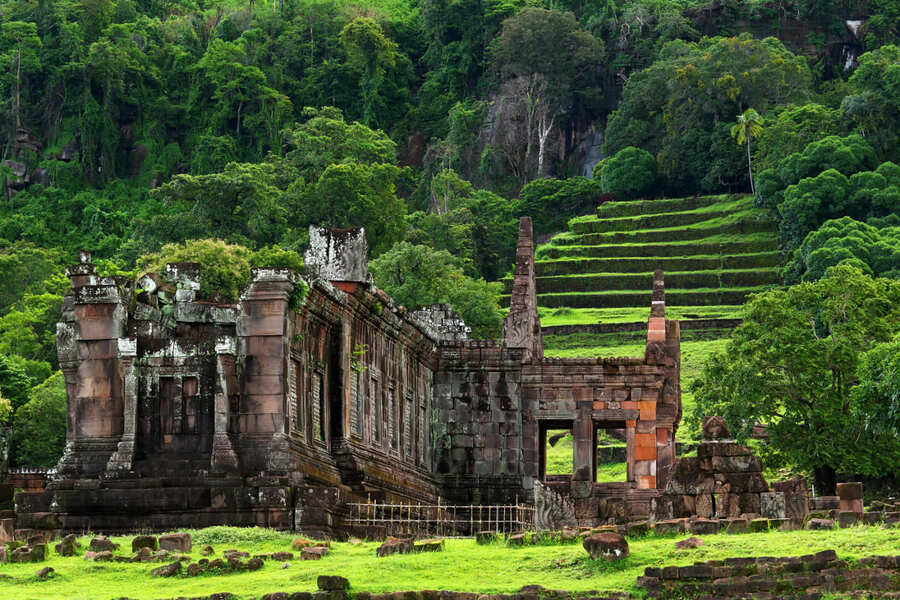
The Wat Phou Festival in February, during the third full moon, features traditional dances and Tak Bat ceremonies, drawing thousands of pilgrims. The nearby museum displays Hindu and Buddhist artifacts, enriching your visit to this Laos UNESCO site.
Travel Tip: Explore Wat Phou via a day trip from Pakse (41 km away). Wear sturdy shoes for the steep stairs and visit the Champasak region’s waterfalls for a complete adventure.
Wat Si Saket – Vientiane’s Historic Laos Buddhist Temple
Wat Si Saket, built in 1818 in Vientiane, is the city’s oldest surviving Vientiane temple, spared during the Siamese invasion of 1828 due to its Siamese architectural style. This Buddhist monastery houses over 10,000 Buddha statues in various sizes, lining its cloisters and ordination hall. Its five-tiered roof, warm-toned walls, and intricate floral ceiling designs create a serene atmosphere. The courtyard features Naga statues and ornate patterns, reflecting Laos cultural heritage.
Restored in the 1930s, Wat Si Saket remains a vibrant worship site and a key stop for travelers exploring Laos Buddhist temples. Its historical resilience and artistic details make it a must-see.
Travel Tip: Visit Wat Si Saket from 8 AM–6 PM (entry ~5,000 kip). Pair your visit with nearby Haw Phra Kaew for a deeper dive into Vientiane’s temple heritage.
Wat Mai Suwannaphumaham – Luang Prabang’s Ornate Laos Temple
Wat Mai Suwannaphumaham, or Wat Mai, is one of Luang Prabang’s largest and most richly decorated Luang Prabang temples. Founded around 1780 by King Anurat, its five-tiered roof and black-and-red lacquered interiors are adorned with gold leaf and murals depicting Buddhist scenes and local life. Located opposite the Royal Palace, it served as a royal temple and once housed the revered Phra Bang Buddha statue, now at Haw Pha Bang, which returns annually for Pi Mai.
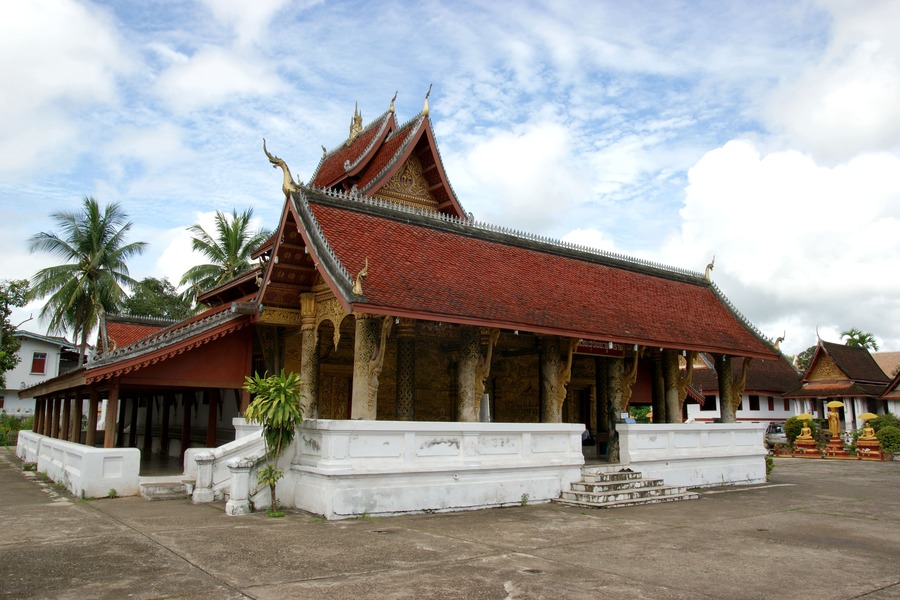
The temple’s vibrant exterior and central location make it a focal point for visitors seeking Laos cultural heritage. Its intricate artistry and spiritual significance are unmissable.
Travel Tip: Visit Wat Mai early morning for a quiet experience (entry ~10,000 kip). Explore the nearby Night Market for handwoven textiles after your visit.
Haw Phra Kaew – Vientiane’s Royal Laos Temple Turned Museum
Haw Phra Kaew, also known as Ho Phra Keo, is a former Vientiane temple built in 1565 by King Setthathirath to house the Emerald Buddha, now in Bangkok. Rebuilt in the 1930s after Siamese destruction, it now serves as a museum of religious arts, displaying Lao Buddhist sculptures and artifacts. Its lush garden, Naga-carved handrails, and intricate carvings of Hindu and Buddhist deities reflect a blend of spiritual traditions, making it a unique Laotian sacred site.
The temple’s elegant architecture and historical significance offer a glimpse into Laos’ royal and religious past, ideal for culture enthusiasts.
Travel Tip: Visit Haw Phra Kaew (8 AM–5 PM, entry ~5,000 kip) and stroll to nearby Wat Si Saket for a comprehensive Vientiane temple tour.
Wat Sene Souk Haram – Luang Prabang’s Vibrant Laos Temple
Wat Sene Souk Haram, or the “Temple of 100,000 Treasures,” is a striking Luang Prabang temple built in 1718 by King Kitsarath with stones from the Mekong River. Its deep ochre facade, accented with gold, and red-and-yellow tiled viharn reflect modern Thai influences. The temple complex includes a canoe shelter with a racing pirogue and a drum shelter, adding cultural charm. Restored in 1957, it remains a vibrant worship site.
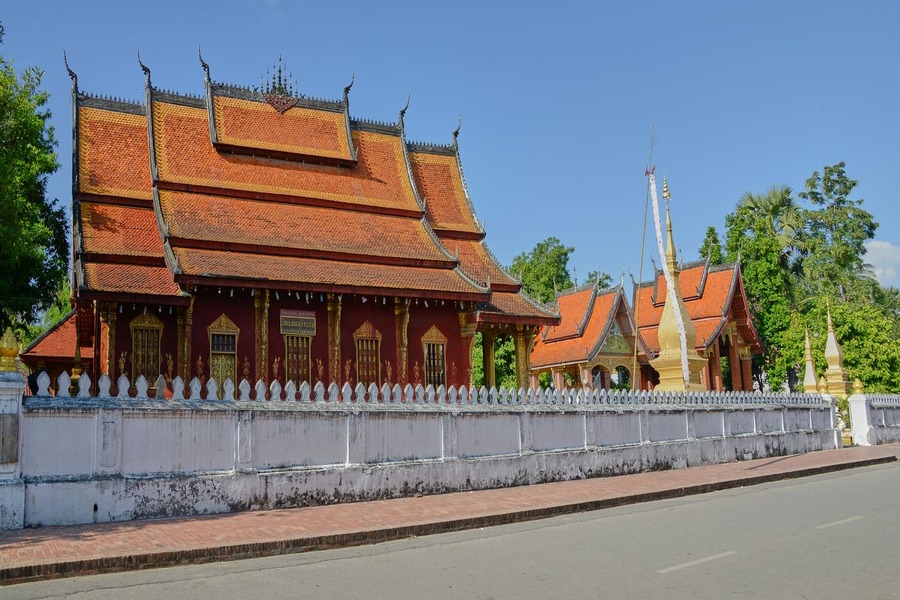
Its central location and flamboyant design make it a standout among Laos Buddhist temples, perfect for travelers seeking visual splendor.
Travel Tip: Visit Wat Sene early morning to engage with monks and enjoy the serene ambiance (free entry). Pair with a visit to the nearby Royal Palace Museum.
Pak Ou Caves – A Sacred Laos Temple in Nature
The Pak Ou Caves, located 25 km upstream from Luang Prabang along the Mekong River, are a unique Laotian sacred site. These limestone caves, nestled in a cliff face, house thousands of Buddha statues left by pilgrims over centuries. Dating to the 16th century, the caves are a spiritual retreat, with the lower cave featuring a shrine and the upper cave offering a meditative atmosphere. Their riverside setting and historical significance make them a must-visit Laos temple.
A boat trip to the caves offers stunning Mekong views and stops at weaving villages, enhancing the cultural experience.
Travel Tip: Take a two-hour boat ride from Luang Prabang to the Pak Ou Caves (entry ~20,000 kip). Visit early to avoid crowds and bring a flashlight for the upper cave.
That Dam – Vientiane’s Mysterious Laos Buddhist Temple
That Dam, or the “Black Stupa,” is a 16th-century Vientiane temple on a quiet roundabout near Talat Sao market. Believed to house a mythical Naga spirit, this enigmatic stupa features a weathered, dark exterior, contrasting with the golden Pha That Luang. Though smaller, its historical and spiritual significance draws locals and travelers. Illuminated at night, it offers a serene setting for evening visits.
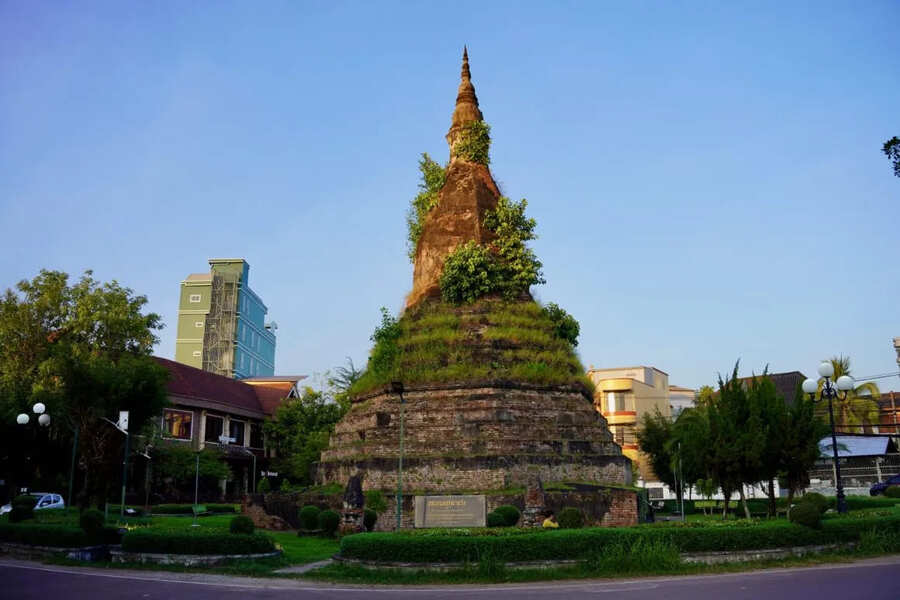
Its understated charm and central location make That Dam a hidden gem among Laos Buddhist temples.
Travel Tip: Visit That Dam in the late evening for its colorful lighting (free entry). Enjoy dinner at nearby restaurants with views of the stupa.
Wat Pa Phon Phao – Luang Prabang’s Hilltop Laos Temple
Wat Pa Phon Phao, a hilltop Luang Prabang temple across the Nam Khan River, is known for its octagonal golden stupa and panoramic views of the surrounding mountains. Built in the 20th century as a forest retreat for meditation, it served as a spiritual haven for Lao kings. Its unique architecture and tranquil setting make it a standout among Laos temples, ideal for those seeking peace and scenic beauty.
The temple’s location offers a quiet escape from Luang Prabang’s bustling center, perfect for reflection.
Travel Tip: Visit Wat Pa Phon Phao at sunrise for breathtaking views (free entry). Wear comfortable shoes for the short hike and respect the meditative atmosphere.
Why Visit Laos Temples
Laos temples are more than architectural marvels—they are living centers of Laos cultural heritage, where monks chant, pilgrims pray, and history unfolds. From the golden splendor of Pha That Luang to the serene caves of Pak Ou, these Laotian sacred sites offer a spiritual journey through Laos’ Buddhist and Hindu past. For travelers, visiting these temples provides a profound connection to the nation’s 49 ethnic groups and their traditions.
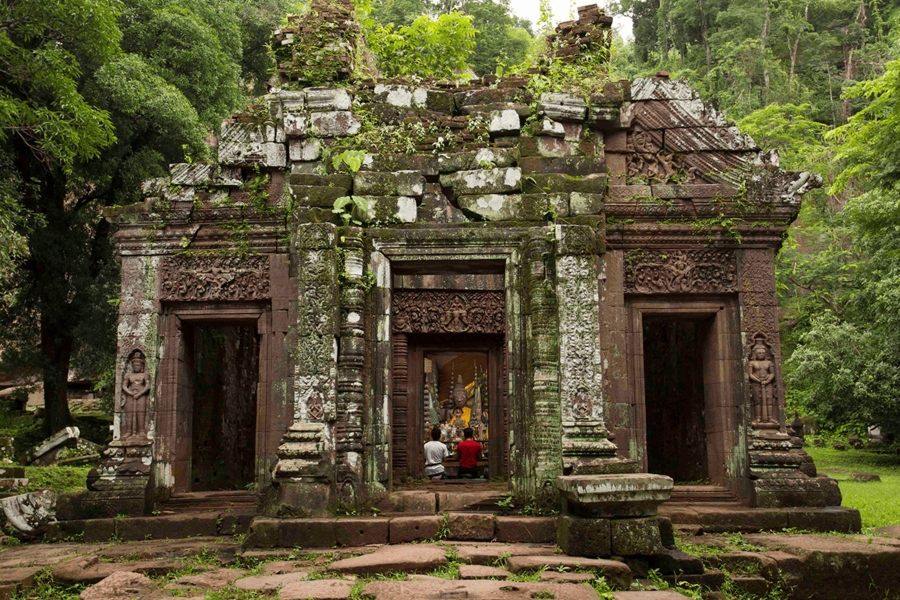
Plan your visit to Luang Prabang temples or Vientiane temples during festivals like Pi Mai (April) or That Luang Festival (November) to witness vibrant ceremonies. Respect temple etiquette by wearing modest clothing (covering shoulders and knees) and removing shoes. For a hands-on experience, join a meditation session at Wat Souvannakhiri or a weaving workshop at Ock Pop Tok to complement your temple tour. Entrance fees are affordable (5,000–30,000 kip), and many temples are free, making them accessible for all travelers.
Pro Tip: Start your journey in Luang Prabang, a UNESCO World Heritage Site, and explore temples by tuk-tuk or bicycle. Combine visits with day trips to Kuang Si Waterfall or the Mekong’s 4,000 Islands for a complete Laos travel guide 2025 experience.
By exploring these top temples in Laos, you’ll uncover the heart of this enchanting land, where spirituality and beauty intertwine.

0 Comment